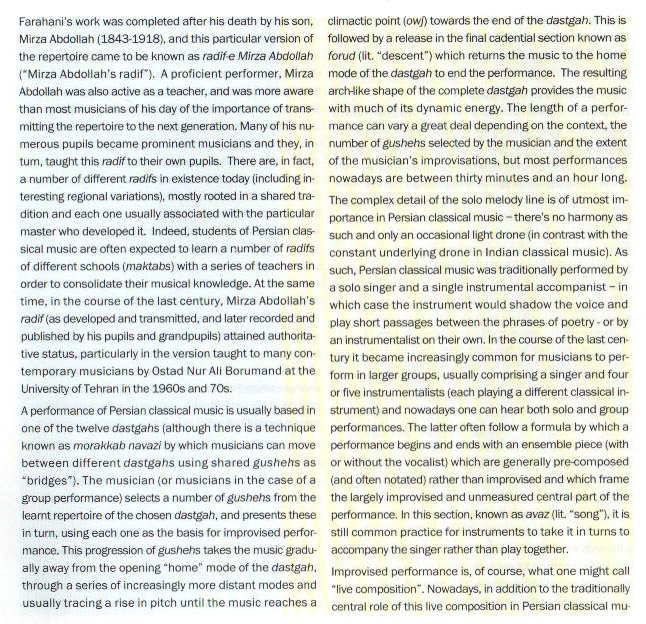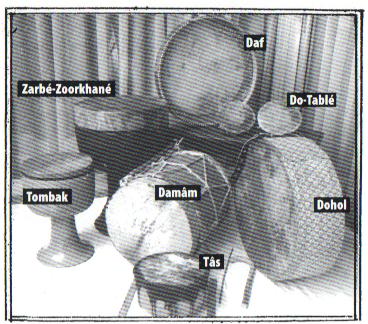
Iranian music
Classical repertoire
The Iranian classical repertoire consists of 12 suites called dastgahs. Each dastgah derives its name from the main mode of its introductory section, or daramad (Segah, Chahargah, Nava, Mahur), and each has its own characteristic interval structure, rythmic formula and melodic motifs. Scale sequences, except in 2 dastgahs (Mahur and Rastpanjgah), are not diatonic as are western major and minor octaves. Instead, a dastgah's defining motif is usually no larger than a tetrachord and has a microtonal-monophonic structure, with intervals smaller than a semi-tone. Microtones are indicated in script with extra symbols, the koron and sori, for lowered and raised pitches respectively.
Every dastgah is made up of a series of small units called gushehs which determine its tetrachord genre. Each gusheh ('corner' or 'section') is an independent piece, containing as few as 4 or 5 notes, with its own particular mode, duration, melody, and performance style. A gusheh can be metric or non-metric, instrumental or non-instrumental, and its classification depends on such complex features as its historical background (folk or classic), its affinity to Iranian classical poetry, its transmitability from one dastgah to another, and its relationship to inter-regional musical systems. There are more than 400 gushehs in the dastgah vocabulary, and each dastgah generally contains 15 to 40 of them, from which the performer chooses 6 to 10 for any given performance


Instruments
Kamancheh
Master of kamancheh: Kayhan Kalhor
This ancient stringed instrument of Iran is the ancestor of most modern bowed instruments. From the Persian words kaman, 'bow' or 'arc', and che, 'little', the kamancheh has a spherical shape, its bridge resting on the surface of a soundbox covered by a membrane of animal skin. Its rounded body, made from different kinds of wood (mulberry, walnut, oak, or maple), has a spike on the bottom to support the instrument. The kamancheh's 4 metal strings are generally tuned in fourths or fifths. The instrument is held vertically and the bow, made of horsehair, moves horizontally, with the performer rotating the instrument when he or she moves from one string to another.
Setar
The Setar is made from thin mulberry wood and its fingerboard has 25 or 26 adjustable gut frets. Setar is literally translated as "three strings"; however, in its present form, it has 4 strings. It has a delicate and intimate sonority.
Tar
The body is a double bowl carved from mulburry wood, with a thin membrane of stretched lambskin for the face. The long fingerboard has twenty-eitght adjustable gut frets. The 3 double courses of strings are played with a plectrum.
Santoor
The santoor is a three-octave wooden-hammered dulcimer with seventy-two strings, which are arranged on adjustable tuning pegs in eighteen quadruple sets, nine (bronze) in the low register, and nine (steel) in the middle register. The santoor can be made from various kinds of wood (walnut, rosewood, betel palm, etc.) depending on the desired sound quality. The front and the back of the instrument are connected by sound posts whose positions play an important role in the sound quality of the instrument. Although the santoor is very old, it was neither depicted in miniatures, nor presented in any other medium until the nineteenth century. The secret of making the trapezoid-shape sound box lies in the quality and age of the wood, as well as in the arrangement of the sound posts which connect the table of the instrument to its back. Santoor is played in India, Iraq, Egypt and some other countries.
Ghanoon
The ghanoon is the Persian zither. It is a flat trapezoidal wooden box, with twenty-four strings in triple fastened at its rectangular side on one end and to pegs on the oblique side on the other. The player to make slight changes in pitch manipulates small levels lying below each course of strings. The strings are plucked with two horn plectra, one on each index finger.
Ney
The ney that is the Persian knotgrass reed, has five finger holes in front and one thumbhole in the back. The ney has a range of two and a half octaves. The upper end is covered by a short brass cylinder, which is anchored in the tiny space between the upper incisive of the player. Sound is produced when a stream of air is directed by the tongue toward the opening of the instrument. In this way, sound is produced behind the upper teeth, inside the mouth, which gives the ney a distinct timbre than that of the sound produced by the lips on the outside of the mouth
Gheychak
The gheychak is a bowed fiddle of the Persian folk music played in the southeastern region of Iran. There are two large holes on the upper side near the fingerboard and one on the lower tip, which is covered with a skin membrane. There are four main strings and eight to sixteen sympathetic strings, which have been eliminated in the context of Persian art music. The sound box resembles an upside-down anchor, which is carved from a tree trunk and is placed vertically on the player's lap. The upper and lower sections are separated by two oval indentations on the right and left side, which give the gheychak a distinct nasal sound. The other instruments of Indian subcontinent such as sarangi, saringda, esraj and dilruba.
Oud
The Oud (or Barbat in Arabic countries) is a short-necked fretless lute with five double-courses of strings and traditionally played with an eagle's quill. The oud is the ancestor of the European lute, and functions as a bass instrument, and is the ancestor of the Chinese pipa as well. The pipa was brought to Japan and was named biwa.
Percussions

Tombak
is a goblet-shaped drum carved from solid mulberry wood and covered at the wide end with lamb or goat skin. It is held horizontallyand played with both hands. The finger technique is extremely elaborate and consists of rolling and snapping the fingers in various ways which allow for a great variety of sounds.
All you want to know about the Tombak: Tombak network
Daf
The daf is considered sacred by the Dervishes of Kordistan. Its consists of a relatively large wooden circular frame (a closed arc) 6 to 7cm wide and 70 to 80cm in diameter. A piece of sheep skin is stretched tightly over one side of the frame. Small chain links hang all around the interior of the frame; the links carry the syncopations and convey a feeling similar to breathing while performing. The daf is normally held up high and is played by both hands. When the daf's skin is torn while performing in a state of self abandonment, the daf is said to have become a martyr. The daf is considered as a Sufi instrument to be played in Khaneghah during Zekr and Sama ceremony. The daf has recently become very popular and it has been integrated into Iranian music successfully.
Dohol
The dohol is one of the most widely used percussion instruments in joyous ceremonies by the Kurdish people, and is found in other parts of Iran as well as some other countries in the world. Along with the sorna (wind instrument), the dohol is played during group dances. It produces a very large and voluminous sound. It has a cylinder like shape made of wood and both sides of the cylinder are covered with skin. The instrument is played by a stick in the shape of a cane in the right hand and a thin stick in the left. The cane like stick plays the strong beats of the rythm, whereas the thin stick plays the ornaments and shorter beats. The dohol hangs from the performer's neck by a strap and is often played outdoors due to its high volume.
Tâs
The tâs is played alongside the daf at the climax of the Samâ. It is constructed from a metallic bowl and covered with skin, stretched tight by belts on the sides of the bowl. This instrument is also played during eclipses and ritual ceremonies for rain on the rooftops in Kurdistan.
Do-Table
It is considered as a wartime instrument by the Kurds. Similar to the tâs, the do-table consists of metallic bowls covered with skin fastened by belts on the sides, and is also played by two short leather straps. The larger drum has a more basic tone whereas the smaller drum has a sharper tone. Do-table resembles the Indian Tabla, except in that the Tabla has a more diffused sound and is played with the fingers.
Damâm
The damâm is one of the most famous instruments in the south of Iran, particularly in Booshehr where it used in most of the ceremonies of that region. The bowl of the damâm has a cylindrical construction covered by skin on both sides and fastenend by straps and ropes on the sides. One can also find instances of it in India as well as certain Arabic and African countries.
Zarbe-Zoorkhaneh
This is one of the ancient percussion instruments of Iran used in sport arenas during a traditional form of sporting activity in order to harmonize movements. It resembles a very large tombak, and its bowl is made of clay. The instrument is placed on the ground due to its heavy weight and is played by both hands.
Links to Iranian music
Livre de référence sur la musique iranienne: Musique d'Iran, de Nelly Caron et Dariouche Safvate, Édition Buchet/Castel, Paris, Janvier 1997